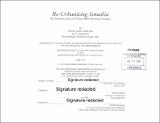| dc.contributor.advisor | Michael Dennis. | en_US |
| dc.contributor.author | Abdel Azim, Mariam Raafat | en_US |
| dc.contributor.other | Massachusetts Institute of Technology. Department of Architecture. | en_US |
| dc.date.accessioned | 2014-11-04T21:33:30Z | |
| dc.date.available | 2014-11-04T21:33:30Z | |
| dc.date.copyright | 2014 | en_US |
| dc.date.issued | 2014 | en_US |
| dc.identifier.uri | http://hdl.handle.net/1721.1/91394 | |
| dc.description | Thesis: S.M., Massachusetts Institute of Technology, Department of Architecture, 2014. | en_US |
| dc.description | Cataloged from PDF version of thesis. | en_US |
| dc.description | Includes bibliographical references (pages 76-77). | en_US |
| dc.description.abstract | Ismailia is a modem Egyptian city located midway along the Suez Canal, the renowned waterway linking the Red Sea to the Mediterranean Sea. The city was developed in 1983 following a French archetype, in collaboration with the French, who were in charge of the operation of the Suez Canal, to serve as the headquarters of the Suez Canal Authority and to house its mainly French and European staff. During the ensuing years, Ismailia remained compact and respected a dense and well-organized urban fabric, following its original plan. However, the city was evacuated in 1967 for six years during the Arab-Israeli war (1948-1973). It was in the latter half of the twentieth century, that Ismailia was re-planned and re-inhabited but with many undefined spaces between and within neighborhoods and that didn't have any clear identity. These neighborhoods lie within a district called Al- Sheikh Zayed, which occupies the whole eastern half of Ismailia. Rather than develop existing vacant plots in the district, the government plans to expand outside the city peripheries towards the desert, essentially creating an extensive, unsustainable urban sprawl. This thesis proposes an alternative plan that creates a legible structure and a recognizable identity within one neighborhood at the heart of the Sheikh Zayed district. Using an urban infill strategy, this proposed plan is based on the premise that compact cities are more sustainable because dense areas share the same infrastructure and public services, are more walkable and bikable, and therefore they save energy and reduce pollution. Through site analysis, I identify an optimal solution for this district that can serve as a model development within Ismailia and can be applied in underdeveloped urban areas within other Egyptian cities. Through my design I introduce a better programming for the neighborhood, provision adequate street network and public and green spaces. The outcome of the thesis is then an urban design proposal for the Sheikh Zayed neighborhood with a block design and a general landscape scheme. | en_US |
| dc.description.statementofresponsibility | by Mariam Raafat Abdel Azim. | en_US |
| dc.format.extent | 80 pages | en_US |
| dc.language.iso | eng | en_US |
| dc.publisher | Massachusetts Institute of Technology | en_US |
| dc.rights | M.I.T. theses are protected by copyright. They may be viewed from this source for any purpose, but reproduction or distribution in any format is prohibited without written permission. See provided URL for inquiries about permission. | en_US |
| dc.rights.uri | http://dspace.mit.edu/handle/1721.1/7582 | en_US |
| dc.subject | Architecture. | en_US |
| dc.title | Re-urbanizing Ismailia : by implementing an urban infill housing strategy | en_US |
| dc.type | Thesis | en_US |
| dc.description.degree | S.M. | en_US |
| dc.contributor.department | Massachusetts Institute of Technology. Department of Architecture | |
| dc.identifier.oclc | 893477455 | en_US |
